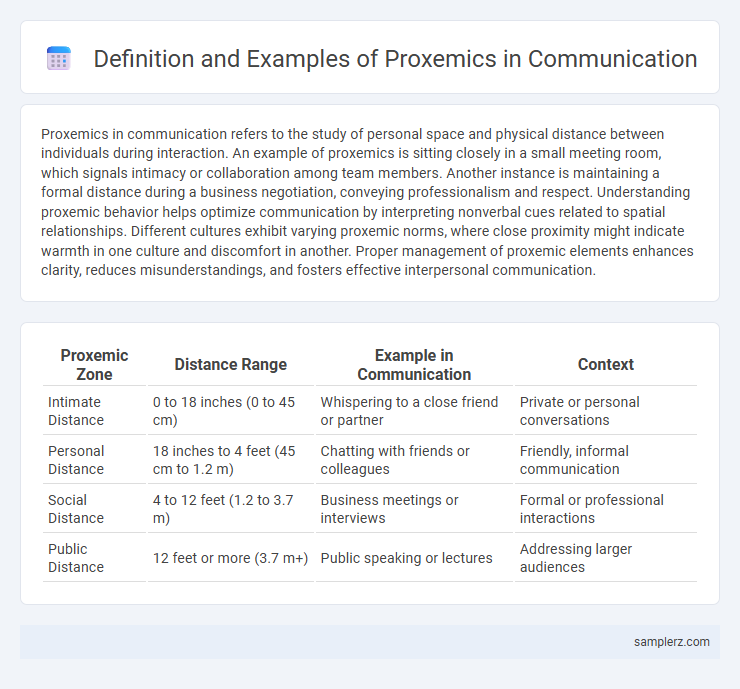Proxemics in communication refers to the study of personal space and physical distance between individuals during interaction. An example of proxemics is sitting closely in a small meeting room, which signals intimacy or collaboration among team members. Another instance is maintaining a formal distance during a business negotiation, conveying professionalism and respect. Understanding proxemic behavior helps optimize communication by interpreting nonverbal cues related to spatial relationships. Different cultures exhibit varying proxemic norms, where close proximity might indicate warmth in one culture and discomfort in another. Proper management of proxemic elements enhances clarity, reduces misunderstandings, and fosters effective interpersonal communication.
Table of Comparison
| Proxemic Zone | Distance Range | Example in Communication | Context |
|---|---|---|---|
| Intimate Distance | 0 to 18 inches (0 to 45 cm) | Whispering to a close friend or partner | Private or personal conversations |
| Personal Distance | 18 inches to 4 feet (45 cm to 1.2 m) | Chatting with friends or colleagues | Friendly, informal communication |
| Social Distance | 4 to 12 feet (1.2 to 3.7 m) | Business meetings or interviews | Formal or professional interactions |
| Public Distance | 12 feet or more (3.7 m+) | Public speaking or lectures | Addressing larger audiences |
Understanding Proxemics: The Role of Space in Communication
Proxemics examines how physical distance impacts communication effectiveness, with intimate space (0-18 inches) facilitating close relationships, personal space (1.5-4 feet) used for conversations among friends, and social space (4-12 feet) typical in professional interactions. The understanding of proxemics enables communicators to adjust spatial behavior according to social context, enhancing message clarity and emotional connection. Cultural differences significantly influence proxemic norms, requiring sensitivity to avoid misunderstandings and foster respectful communication.
Zones of Personal Space: Intimate, Personal, Social, and Public
Zones of personal space in communication define how physical distance impacts interaction, with the intimate zone ranging from 0 to 18 inches reserved for close relationships like family and partners. The personal zone spans 1.5 to 4 feet, common for conversations with friends and colleagues, while the social zone, between 4 and 12 feet, suits professional or casual interactions. The public zone extends beyond 12 feet, ideal for public speaking or addressing large groups, emphasizing comfort and appropriateness in different communication contexts.
Cultural Differences in Proxemic Behavior
Cultural differences in proxemic behavior significantly impact communication, with some cultures valuing close personal space, such as Latin American and Middle Eastern societies, while others, like Northern European and East Asian cultures, prefer more considerable distance to convey respect and formality. Understanding these variations in physical distance during interactions prevents misinterpretations and fosters effective cross-cultural communication. Proxemic norms influence nonverbal cues, affecting comfort levels and the perception of intimacy or aggression between communicators from diverse backgrounds.
Proxemics in the Workplace: Office Layouts and Interactions
Proxemics in the workplace significantly influences office layouts and employee interactions by defining personal space boundaries and spatial arrangements. Open-plan offices promote collaboration through reduced physical barriers, while cubicles establish privacy and minimize distractions, impacting communication efficiency. Understanding these spatial dynamics helps optimize team interactions and workplace productivity.
Proxemic Examples in Educational Settings
Proxemic examples in educational settings include the physical distance maintained between teachers and students, which can influence classroom engagement and authority perception. Seating arrangements such as circular or U-shaped setups promote collaborative learning by reducing interpersonal space and encouraging interaction. Additionally, the use of personal space during one-on-one tutoring sessions impacts student comfort and information retention.
Nonverbal Cues: Proxemics in Social Gatherings
In social gatherings, proxemics plays a crucial role through nonverbal cues such as personal space, body orientation, and physical distance, signaling intimacy, formality, or social hierarchy. For instance, standing closer during conversations indicates trust and familiarity, while maintaining greater distance suggests formality or discomfort. These nonverbal spatial behaviors help individuals navigate social interactions and interpret underlying relational dynamics.
Proxemics in Healthcare: Patient and Provider Interactions
Proxemics in healthcare significantly influences patient and provider interactions by regulating personal space to enhance comfort and trust. Maintaining appropriate physical distance during consultations can reduce anxiety and foster open communication, improving patient outcomes. Studies show that respecting cultural proxemic norms ensures clearer understanding and more effective therapeutic relationships in clinical settings.
Proxemic Considerations in Virtual Communication
In virtual communication, proxemic considerations involve managing spatial cues despite physical distance, such as maintaining appropriate screen distance to simulate personal space and ensuring clear visual angles for nonverbal gestures. Video conferencing platforms incorporate features like grid views and spotlight modes to replicate face-to-face proximities, enhancing engagement and minimizing misinterpretations. Understanding virtual proxemics improves communication effectiveness by respecting interpersonal boundaries and cultural differences in digital interactions.
Proxemic Signals in Romantic Relationships
Proxemic signals in romantic relationships include variations in physical distance, such as intimate spacing within 18 inches, which conveys closeness and affection. Touch frequency and duration, like holding hands or gentle caresses, serve as powerful indicators of emotional intimacy and attachment. Eye contact patterns and body orientation further enhance nonverbal connection, reinforcing mutual interest and trust between partners.
Impact of Proxemics on Effective Team Communication
Proxemics significantly influences effective team communication by shaping how physical distance affects interaction and collaboration among members. Maintaining appropriate spatial zones, such as personal and social distances, enhances comfort levels, reduces misunderstandings, and fosters trust within the team. Mismanagement of proxemic cues can lead to communication barriers, decreased cooperation, and lower overall team performance.

example of proxemic in communication Infographic
 samplerz.com
samplerz.com